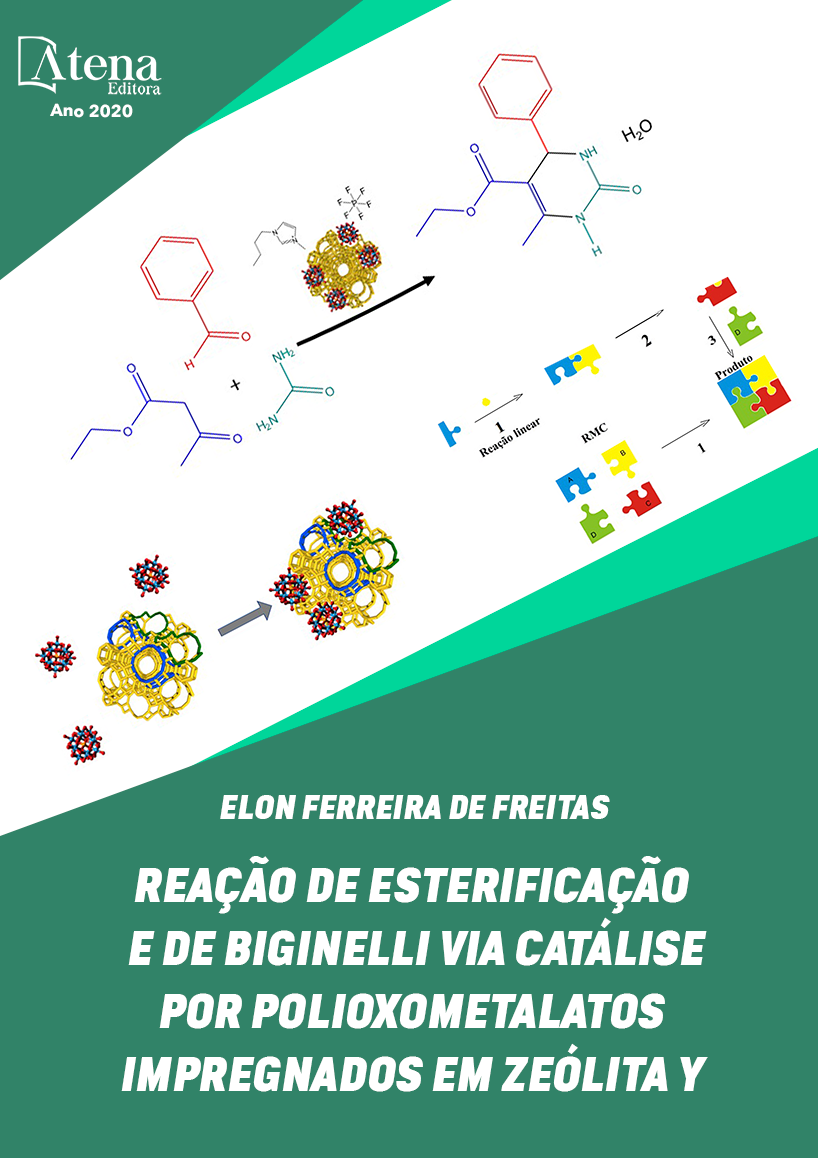
REAÇÃO DE ESTERIFICAÇÃO E DE BIGINELLI VIA CATÁLISE POR POLIOXOMETALATOS IMPREGNADOS EM ZEÓLITA Y
Zeólitas e polioxometalatos são catalisadores utilizados em processos ambientais importantes e sua combinação produz um novo sólido adaptando com vantagens de ambos os catalisadores. Neste trabalho, materiais com H3PW12O40 ou H4SiW12O40 suportado em zeólita Y foram preparados por impregnação incipiente e aquosa, mantendo a estrutura de Keggin. A dispersão de H3PW12O40 ou H4SiW12O40 sobre a superfície da zeólita Y levou a formação de nanocristais de 5 nm e 23 nm, respectivamente. Embora a cristalinidade tenha diminuído com o carregamento de HPA, as imagens MEV mostraram que a morfologia original da zeólita Y foi conservada e uma forte interação entre os sólidos poderia ser inferida a partir dos espectros de RAM RMN. A formação de mesoporos secundários na estrutura da zeólita Y foi relacionada ao processo de desaluminação parcial que ocorreu durante a impregnação. A impregnação de heteropolíácidos na zeólita Y resultou no desaparecimento dos sítios de Lewis, devido a interação com o ânion de Keggin, fazendo com que o sólido tenha predominantemente sítios do tipo Brønsted. Os novos sítios mantiveram força ácida superiores a -100 kJ mol-1 com um número geralmente maior porque os sólidos individuais tiveram aproximadamente a mesma força ácida dos sítios (-147 kJ mol-1). Foi observada uma conversão mais elevada (77%) para a reação de esterificação para as amostras preparadas por impregnação incipiente. Adicionalmente, os sólidos ácidos preparados por impregnação aquosa foram também aplicados na reação multicomponente (RMC) de Biginelli para produzir a 3,4 dihidropirimidina-2(1H)-ona (DHPM). A otimização do sistema de reação foi realizada e resultados promissores foram obtidos com 99% de rendimento para a reação de benzaldeído, acetoacetato de etila e ureia (proporção em mmol 1:1:1), contendo 50 mg de 28%HSiW/Y-AQ, líquido iônico hexafluorfosfato de 1-N-butil-3-N-metil-imidazólio (BMI.PF6) como solvente, a 100 °C e tempo de reacional de 1 h. Os resultados demonstraram que a elevada força ácida do catalisador é essencial para obter bons rendimentos na reação de esterificação, enquanto que para a reação MCR de Biginelli, a existência de um maior número de sítios ácidos é mais importante do que a força ácida do catalisador.
REAÇÃO DE ESTERIFICAÇÃO E DE BIGINELLI VIA CATÁLISE POR POLIOXOMETALATOS IMPREGNADOS EM ZEÓLITA Y
-
DOI: 10.22533/at.ed.607201703
-
Palavras-chave: Atena
-
Keywords: Atena
-
Abstract:
Zeolites and polyoxometalates are catalysts used in important environmental processes and their combination produces a new solid tailoring the advantages of both catalysts. In this work, supported H3PW12O40 or H4SiW12O40 on zeolite Y was prepared by incipient and aqueous impregnation, which maintained the Keggin structure. The dispersion of H3PW12O40 or H4SiW12O40 on zeolite Y surface lead to nanocrystals of 5 nm and 23 nm, respectively. Although the crystallinity decreased with HPA loading, the SEM images showed that the original morphology of zeolite Y was conserved and a strong interaction between the solids could be inferred from the MAS NMR spectra. Enhanced formation of secondary mesopores on the zeolite Y structure was related to the partial dealumination process that took place during the impregnation. Heteropolyacid impregnation on zeolite Y resulted on the disappearance of the Lewis sites, because of the interaction with the Keggin anion, thus causing the solid to have predominantly Brønsted type sites. The new sites kept the strengths higher than −100 kJ mol−1 with a generally increased number because the individual solids had about the same strength of sites (−147 kJ mol−1). Higher conversion (77%) for esterification reaction was observed for the samples prepared by incipient impregnation. In addition, the solid acids prepared by aqueous impregnation were also applied in the multicomponent reaction (MCR) of Biginelli to produce the 3,4 dihydropyrimidin-2(1H)-one (DHPM). The optimization of the reaction system was carried out and promising results were obtained with 99% yield for the reaction of benzaldehyde, ethyl acetoacetate and urea (mmol ratio 1:1:1), containing 50 mg of 28%HSiW/Y-AQ, 1-butyl-3-methylimidazolium hexafluorophosphate (BMI.PF6) ionic liquid as solvent, at 100 °C and reaction time of 1 h. The results have demonstrated that high acidic strength of the catalyst is essential to obtain good yields in the esterification reaction, whereas for Biginelli's MCR reaction, the existence of a greater number of acidic sites is more important than the acidic strength of the catalyst
-
Número de páginas: 104
- Elon Ferreira de Freitas


